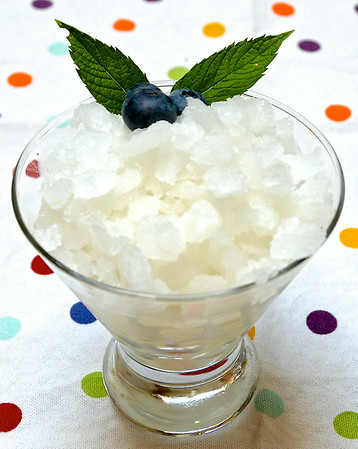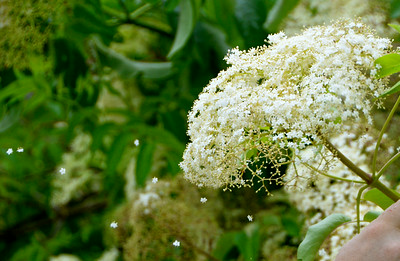
ELDERFLOWER GRANITA DRESSED WITH BLUEBERRIES AND MINT
At one time, when I heard “elderflower cordial,” I imagined garden parties in the English countryside where formally attired guests sipped pale yellow drinks from elegant crystal goblets. In reality not once in my half dozen trips to England has anyone ever invited me to or mentioned attending such a soiree. Been offered a glass of chilled elderflower cordial? Nope. That hasn’t happened either.
Until a few weeks ago I hadn’t thought much about consuming or even picking elderflowers. Then two old friends mentioned that they were making elderflower cordial from their farm’s elderberry trees. With that my visions of genteel garden parties and fancy drinks returned and I became intrigued by the flower’s culinary possibilities.

DELICATE ELDERFLOWERS FLOATING AWAY FROM THEIR STEMS
Found throughout Europe, North America and Western Asia, elderberry trees bear clusters of tiny, edible, white flowers and small, blackish-purple berries. The latter get made into chutneys, jams, jellies, sauces, soups and wine while the former show up in cordials, teas, jellies, baked goods and, oddly enough, fritters. As you might expect, elderflowers impart a pleasant floral flavor to these foods.
When mixed with boiling water and sugar and allowed to steep for at least 24 hours, elderflowers transform into elderflower syrup. Add citrus juice and zest and seltzer or water to the syrup and you have the sweetly tart and flowery drink known as elderflower cordial. That is all it takes to create my romanticized drink.
Yearning to try this idealized beverage, I made a weekend trip to my friends’ farm and collected enough flowers for a batch of cordial. On the way home I started thinking about what else I could do with these little gems. Why stop at a cordial when I could stir up an exquisite elderflower granita?
ELDERFLOWER GRANITA
Makes 4 cups
If you cannot find fresh elderflowers, you can use commercially produced elderflower cordial. IKEA, among others, carries this. If you do use fresh flowers, be sure to rinse them thoroughly and remove any bugs or debris from them.
For a refreshing summertime drink, add the leftover cordial to water, plain seltzer, white wine or vodka.
for the cordial:
2 cups water
2 1/4 cups granulated sugar
2 cups fresh elderflowers, well-rinsed and drained
Zest and juice of 2 lemons
1 orange, sliced
for the granita:
2 cups elderflower cordial
2 cups water
Juice of 1 lime
Fresh mint, optional, for garnish
Fresh blueberries or black raspberries, optional, for garnish
To make the cordial, place the water and sugar in a medium saucepan and, over medium heat, bring the ingredients to a boil. Cook, stirring occasionally, until the sugar has dissolved. Add the elderflowers, stir to combine and remove the pan from the heat. Pour the liquid into a large glass bowl and cool slightly.
Add lemon juice and zest and orange slices and stir the ingredients together. Loosely cover the bowl and place it in a cool spot. Periodically stirring the mixture, allow it to steep for 24 to 36 hours.
When the cordial has reached its desired strength, strain it through a fine mesh or cheesecloth-lined colander and into a pitcher. Discard the flowers, orange slices and lemon zest. Using a funnel, pour the cordial into lidded jars or bottles. Refrigerate until you’re ready to make the granita.
To make the elderflower granita, pour 2 cups cordial, 2 cups cold water and the lime juice into a shallow pan or bowl and stir to combine. Place the pan in the freezer for a minimum of 8 hours. For the first 2 hours, remove the pan every 20 to 40 minutes and stir the contents, making sure to scrape down the sides of the dish and incorporate both the iced and still-liquid granita.
Once the granita is completely frozen, use a large spoon to scrape the top to form a single serving. Place the granita in a cocktail glass or bowl and enjoy.